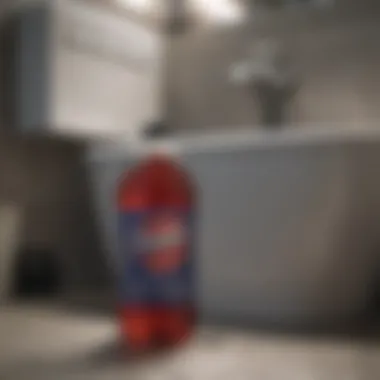Can You Safely Use Drano in Your Toilet?


Intro
Using chemical drain cleaners like Drano can seem like a quick fix for stubborn clogs. However, when it comes to your toilet, the situation may not be as straightforward. While Drano is effective in sinks and tubs, its use in toilets raises significant concerns. This article seeks to explore why using Drano in toilets may not be advisable. It will delve into the product's chemical properties, the associated risks, and alternative methods for maintaining clear plumbing.
Homeowners often look for effective solutions to plumbing challenges. The ease of pouring chemicals into a clogged toilet might appear attractive, but the consequences can be severe. Understanding how to properly manage toilet clogs will not only help prevent damage to plumbing fixtures but also enhance overall toilet maintenance.
In the following sections, we will examine both the efficacy and dangers of Drano, providing insights from plumbing professionals on the best practices for toilet care.
Understanding Drano and Its Functionality
The topic of understanding Drano and its functionality is paramount in addressing the question of whether it can be safely used in toilets. Recognizing how Drano works, along with its components, aids in grasping both its effectiveness and potential hazards when misused in this context.
When tackling clogged toilets, many may consider reaching for Drano as a quick fix. However, the implications of using such a chemical drain cleaner are complex. Being well-versed in its characteristics can make a significant difference in plumbing outcomes and safety.
What is Drano?
Drano is a widely used brand of drain cleaning products made to dissolve clogs in plumbing systems. Originating from the need for effective unclogging solutions, Drano aims to provide homeowners with an easy way to address common drain issues without requiring professional help. Its accessibility in stores makes it a go-to for many.
The Composition of Drano
Active Ingredients
The active ingredients of Drano primarily include sodium hydroxide (lye), bleach, and aluminum. Sodium hydroxide is notable because it reacts vigorously with water and organic materials, breaking them down effectively. This reaction generates heat, which helps to clear clogs efficiently. While its strength makes it effective, caution is essential as it can also damage plumbing fixtures if misapplied.
How It Works
Drano works through a chemical reaction that raises temperature and breaks apart the materials causing clogs. This process not only disintegrates hair and grease but can also clear soap scum, food particles, and other waste. The high heat produced during the reaction assists in melting stubborn clogs, allowing them to be washed away with water. Although it is popular for its effectiveness, it can pose risks if used improperly or in wrong situations.
Types of Drano Products
Drano offers various products designed for different types of clogs and scenarios.
Drano Max Gel
Drano Max Gel features a thicker formula that adheres to clogs longer than traditional liquids. This unique characteristic allows it to dissolve tough blockages effectively. Many find it appealing because of its ability to cling to vertical pipes, maximizing its cleansing potential. However, it is important to use it cautiously in toilets, as it may not be compatible with all toilet types.
Drano Liquid


The standard Drano Liquid operates similarly to its gel counterpart but has a more fluid consistency. This liquid is capable of flowing through pipes quickly, which can be beneficial for light clogs. Despite being easier to pour, the risks associated with its use in toilets remain significant due to the potential for damage and adverse reactions in the plumbing.
Drano Dual-Force Cleaner
Drano Dual-Force Cleaner combines both gel and foam technologies. As a result, it claims to deliver a double-action formula that ensures comprehensive cleaning. This dual-layer approach is designed to target both tough and easy clogs effectively. Nonetheless, its strong chemical makeup means it should be used with caution, especially in sensitive plumbing systems.
Application of Drano in Toilets
The application of Drano products in toilets brings up significant concerns and considerations for homeowners. Clogs can disrupt daily activities, and many turn to chemical solutions for quick relief. However, the appropriateness and effectiveness of using Drano in toilets require careful examination. The foremost element is safety; not all plumbing systems are compatible with harsh chemicals. Thus, understanding how Drano interacts with toilet components is important.
Another consideration is the potential for long-term damage. While Drano may provide a temporary solution to a clog, the chemical reactions can weaken pipes and seals, eventually leading to costly repairs. Assessing the risks involved is essential for making an informed decision that serves not just immediate needs, but long-term plumbing health.
Moreover, there are environmental impacts and health considerations that cannot be ignored. Using Drano is not just about addressing a symptom; it can affect the broader ecosystem through the plumbing systems. We will explore these elements in detail.
Can You Safely Use Drano in Toilets?
Using Drano in toilets is allowed, but it is fraught with risks. Many users report that it has helped them in unclogging issues, yet safety lies in nuances. Toilets contain components like porcelain and wax seals that can be sensitive to aggressive chemicals. The nature of clogs also plays a role; organic matter dissolves differently compared to foreign objects.
Homeowners should be cautious and verify product labeling. Manufacturer instructions provide guidance on safe usage. If there's uncertainty, alternatives can be considered to avoid potential pitfalls.
Risks Involved with Using Drano in Toilets
Potential Damage to Pipes
Potential damage to pipes is a salient concern when using Drano in toilets. The harsh chemicals in Drano can cause corrosion over time. Materials like PVC or metal pipes might react negatively, weakening structural integrity. A key characteristic here is that once pipes are compromised, leaks may arise, leading to further complications.
Many homeowners find themselves facing plumbing issues that arise from improper product use, resulting in costly repairs down the road.
Health Hazards
Health hazards associated with Drano use are significant. Drano contains toxic compounds which can cause respiratory irritation. In poorly ventilated spaces, the chemical fumes can be harmful. It is crucial for users to be aware of these hazards. Protective gear such as gloves and masks is often recommended when handling such products. This inspection of health impacts emphasizes the need to make informed choices, particularly when considering the safety of household members.
Plumbing Considerations
Compatibility with Plumbing Systems
Compatibility with plumbing systems is critical. Not all plumbing is designed to handle chemical drain cleaners like Drano. For example, older homes may have systems that are more vulnerable to chemical reactions. Key characteristics of effective plumbing systems include sturdiness and material suitability. Homeowners should assess the material of their pipes and consult professionals if uncertain. Misunderstanding these aspects can lead to disastrous results.
Impacts on Septic Systems


Impacts on septic systems are another vital area of concern. Drano can disrupt the biological processes in septic tanks. The chemicals can kill beneficial bacteria essential for breaking down waste materials. This disruption can lead to system inefficiencies and require costly maintenance or repairs. It is essential to highlight this unique feature of septic systems; once contamination occurs, recovery can be slow and difficult.
In summary, the application of Drano in toilets involves carefully weighing its benefits against potential risks and compatibility with your home's plumbing system. Opting for alternatives could be a safer, more sustainable choice.
Alternatives to Drano for Toilet Clogs
Exploring alternatives to Drano for toilet clogs is a vital section in understanding how to effectively manage plumbing issues without incurring significant damage or health risks. Homeowners often resort to chemical solutions out of convenience but may overlook simpler, safer methods. By investigating these alternatives, one can appreciate the various tools and strategies available that can mitigate issues without the adverse effects commonly associated with harsh chemicals.
Using a Plunger
The plunger is one of the oldest and most effective tools for clearing clogs. It uses suction to dislodge blockages in toilets. It is highly preferred due to its straightforward mechanism and non-toxic approach.
- How to Use: Position the rubber cup over the toilet drain and push down gently to remove air, then pull up sharply. Repeat this action until the water drains effectively.
- Benefits: It is cost-effective, readily available, and poses no risk of damaging pipes or causing health concerns.
- Considerations: Some clogs may require vigorous plunging, which could lead to splashing. Using proper technique minimizes mess.
Employing a Toilet Auger
A toilet auger, also known as a plumbing snake, is another viable option for tackling stubborn clogs that a plunger cannot remove. This tool consists of a long, flexible metal cable and a coiled end that can break up or retrieve blockages.
- How to Use: Insert the auger into the toilet bowl, directing the coiled end into the drain. Rotate the handle to push the cable into the clog, breaking it up or hooking it to pull it out.
- Benefits: This method is effective for deeper clogs that are inaccessible with other methods.
- Considerations: Though effective, improper use can scratch the porcelain of the toilet or push the clog further down.
Homemade Solutions
Utilizing homemade solutions can often solve clogged toilets without the need for harsh chemicals.
Baking Soda and Vinegar
Using a combination of baking soda and vinegar is a widely recognized home remedy for unclogging toilets. This combination creates a fizzy reaction that can aid in breaking down minor blockages.
- Key Characteristic: This method is well-regarded for being safe and environmentally friendly. It does not harm pipe systems.
- Unique Feature: The fizzing action helps to break down organic matter and mild clogs quickly, making it a beneficial choice.
- Advantages/Disadvantages: While effective for small clogs, it may not work for large, stubborn blockages and generally takes longer than chemical solutions.
Hot Water Method
Employing hot water is a simple yet effective strategy for some clogs. Pouring hot (not boiling) water into the toilet can help break down the materials causing the blockage.
- Key Characteristic: Hot water is easy to use and requires no special tools or ingredients.
- Unique Feature: It can quickly dissolve soap accumulations and other substances that form clogs.
- Advantages/Disadvantages: This method is safe and inexpensive but may not be effective for severe blockages that require more intensive methods.
Using these alternatives not only maintains the plumbing system's integrity better than harsh chemicals but also promotes safer practices for home upkeep.
Expert Recommendations for Toilet Maintenance


Maintaining a toilet is a crucial aspect of home care. Proper maintenance ensures longevity, efficiency, and reduced likelihood of costly repairs. Understanding how to take care of your toilet can improve hygiene and overall comfort at home. There are several procedures and practices that can help maintain toilet functionality while preventing build-up and clogs. This section will provide insights into essential maintenance strategies, empowering homeowners with the knowledge to avoid common pitfalls.
Regular Maintenance Tips
Regular maintenance is essential to keep your toilet in optimal condition. One of the basic tasks is to check for leaks. A simple way is to add a few drops of food coloring to the tank; if the color seeps into the bowl without flushing, there may be a leak. Secondly, it is beneficial to clean the toilet regularly with appropriate cleaning agents. Using a toilet brush and disinfectant can help keep limescale and bacteria at bay.
Additionally, consider using a toilet bowl cleaner that is safe for your plumbing system. Following manufacturer guidelines will ensure that you do not cause any damage. More so, flushing the toilet properly by facing the water down is important to prevent additional currents that could cause clogging.
When to Call a Professional
Not all toilet issues can or should be resolved by homeowners. Awareness of when to seek professional intervention is an important maintenance strategy. If you encounter frequent clogs despite routine maintenance, or if there are persistent leaks, reaching out to a plumber is advisable. Sometimes, underlying issues such as corroded pipes or septic tank problems may exist. Ignoring these signs can lead to more extensive damage and costly repairs.
Always remember, a small unresolved problem can escalate quickly if not addressed in time.
Preventative Measures
Preventative measures play a significant role in toilet maintenance. By being proactive, you can reduce the risk of clogs and prolong the lifespan of your toilet. Following are two effective methods to consider:
Proper Waste Disposal
Proper waste disposal is fundamental for preventing toilet blockages. Toilets are designed mainly for human waste and toilet paper. Flushing inappropriate items like wipes, feminine products, or cotton swabs can lead to serious clogs. Understanding what can safely go down the toilet is essential to minimizing issues. Moreover, promoting education about waste management in the household can prevent costly problems in the future.
Regular Inspections
Regular inspections ensure that your toilet remains in serviceable condition. Inspecting connections, seals, and visible parts can help identify early signs of wear and tear. This practice allows for timely repairs before they become major headaches. Regular inspections are a proactive choice, saving significant time and expenses in the long run. Simple checks can distinguish between minor issues and serious plumbing problems, providing peace of mind and maintenance control.
Culmination: The Bottom Line
The topic of whether Drano can be used in toilets is significant for homeowners who face frequent plumbing issues. With the potential for clogs at inconvenient times, finding effective solutions is crucial. This article highlights the risks and alternatives to using Drano in toilets, thus offering an informed perspective on plumbing safety and maintenance.
Here are some key elements regarding the conclusion about using Drano in toilets:
- Risk of Damage: Utilizing Drano in toilets can lead to considerable risks. From damaging pipes to compromising septic systems, the adverse effects can outweigh the temporary benefits of unclogging.
- Health Considerations: The chemicals in Drano, while effective in certain contexts, pose health risks if mishandled. Fumes can irritate, and improper use can lead to hazardous situations.
- Alternative Solutions: There are various alternatives for handling toilet clogs. Using a plunger or toilet auger presents safer and more effective methods without the associated risks of chemical products. Homemade solutions like baking soda and vinegar can also be sufficient for minor clogs.
- Expert Insight: Professional guidance is invaluable. Knowing when to consult a plumber can save time, money, and potential damage to plumbing systems. Regular maintenance is also highlighted as a preventative measure against clogs.
Ultimately, homeowners must weigh the pros and cons of using Drano in their toilets. By being informed about the potential risks and exploring other methods, they can make choices that promote long-term plumbing health and safety.
Final Thoughts on Using Drano in Toilets
In summary, while Drano is a popular choice for unclogging sinks and shower drains, it is fundamentally unsuitable for toilets. The chemical composition, designed for heavy-duty cleaning, can react negatively within toilet plumbing systems. The likelihood of pipe damage, health issues, and other complications should discourage its use in such contexts.
- Lack of Effectiveness: Toilet clogs differ from those in sinks or showers. The nature of clogs often requires more mechanical methods of removal rather than chemical ones.
- Damage to Plumbing: Many pipes, particularly older ones, can be sensitive to harsh chemicals. Drano's caustic nature poses a risk to various plumbing materials, leading to leaks or bursts.
- Professional Recommendations: Consulting a plumbing professional or conducting routine inspections can mitigate the risks associated with stubborn clogs. Experts emphasize the importance of using safe and appropriate methods.
"Using harsh chemicals often results in more damage than resolution. It's better to prioritize methods that are gentle on plumbing yet effective for unclogging."
When faced with plumbing troubles, it is wise to seek a solution that ensures safety and effectiveness rather than taking unnecessary risks. Therefore, avoiding Drano in toilets promotes healthier plumbing systems and overall home safety.















